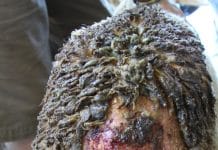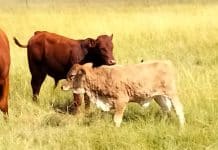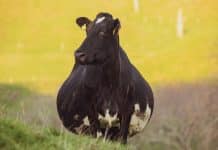Estimated reading time: 7 minutes
The first three articles in this series focussed on the optimal use of rainfall to produce feed. However, all these efforts are wasted if a livestock producer does not have a herd or flock that can efficiently convert grazing into money.
Climate-smart livestock producers need animals that can efficiently convert veld into production and profit. Reproductive productivity is one of the measures used to calculate a herd or flock’s ability to convert feed into profit. This is the result of the amount of live weight the herd or flock produces, as a factor of the total weight of the breeding herd or flock. It is measured in kilograms of meat produced per kilogram of breeding animal.
Read part 3 of the series here.
This measure considers all the variables of reproduction, including conception, weaning percentage, weaning weight, marketing percentage and marketing weight. Optimal productivity is achieved when the maximum number of breeding animals conceive, complete their pregnancy, comfortably give birth to viable and healthy offspring, rear their offspring well and wean as many offspring as possible.
Small stock
Small-stock producers should pay attention to a number of factors so that as many breeding animals as possible can complete this process. However, two important factors are often overlooked: procedure during replacement ewe selection and age structure of the breeding flock.
Each flock has substandard, moderate or excellent performers. The secret lies in identifying and culling the passengers early.
Replacement ewes
Replacement ewes demonstrate their future ability as breeding ewes at an early age. A study into the lifetime reproduction of 1 603 replacement ewes in the Grootfontein, Carnarvon and Elsenburg Merino flocks investigated the relationship between the ewes’ weaning percentage at two-tooth age and over the remainder of their life.

This research found that Merinos demonstrate their superior overall production potential at an early age. Several subsequent projects, which studied different small-stock breeds, yielded similar findings. This means the trait has high repeatability across different small-stock types and breeds.
In short, every small-stock flock has breeding animals that conceive easily, complete their pregnancy, give birth without problems, care well for their lambs and wean them successfully. Likewise, every flock has breeding ewes that produce very few offspring.
The secret to building a reproductively efficient breeding flock is to identify and cull below par performers at a young age. To develop a highly successful flock, you need to select for it. It starts with consistently culling young ewes that fail to wean a lamb during their first lambing opportunity.
Upon weaning, cull only ewe lambs that are very small and stunted, as well as those that do not meet the breed standards. Retain the rest. Before mating, cull the 5 to 10% worst performing ewes and those that have developed cull defects in the interim. The rest are then mated.
The final selection is made from the pregnant ewes, with preference given to those that carry multiples (provided that normal reproduction techniques have been used – no pregnant mare serum). Young ewes that fail to raise a lamb are culled, unless the cause could be attributed to management errors.
While young ewes with exceptional reproduction during their first lambing opportunity have an above-average chance of sustaining this trait over their lifetime, there is still a percentage that will not. Hence, it is necessary to continually discriminate against ewes that do not hit the mark.
Cull all ewes that fail to conceive. If the conception rate of mature ewes is 90% and above, those that are dry should be culled. If only 50% of the ewes conceive, the problem lies elsewhere and in this case, dry ewes must be retained. In young ewes a conception rate of 70% and higher applies.
Cull all ewes that conceive but fail to lamb, or that lamb but do not wean a lamb, or that wean lightweight lambs. Do not, however, penalise ewes that produce poorly due to management errors!
Growing out young ewes
The reproductive system of a ewe lamb develops systematically from birth to puberty. This process must take place systematically and progressively to ensure she reaches her full reproductive potential.
Weaned lambs earmarked as replacement ewes are often neglected from weaning to first mating. They not only have difficulty reaching their ideal mating weight, but they are also physiologically (hormones and reproductive organs) not ready for breeding. This disadvantage is difficult to rectify after puberty, resulting in lower lifetime reproduction compared to ewes that have grown out well between weaning and puberty.
Age structure of ewe flock
Ewe fertility increases with age (Figure 2). As they mature, their conception rate increases as does the percentage of multiples, whereas the number of lambs weaned decreases after six years of age.

The age structure of the breeding flock is therefore crucial when pursuing maximum reproductive productivity. A breeding flock must consist of a hierarchy of young to older breeding animals. A breeding flock with mainly older ewes is indicative of substandard reproduction and a shortage of weaner ewes to replace older ewes.
Rams
There is no point having ewes in excellent mating condition, only to have rams that are not ready. Virile rams with good mating dexterity and libido, and which are fertile, healthy, fit and well fed, are vital for maximum ewe conception.
For example, ewes mated only once during their oestrus cycle have a conception rate of 50%, and only 17% have multiples, compared to ewes mated three times that have a conception rate of 91% and 54% multiples.
Beef cattle
Replacement heifers
As with small stock, replacement heifers are a key element in the improvement of herd reproduction. Weight is a key factor once heifers reach puberty. For optimal reproduction heifers should reach their target weight of 60 to 65% of adult weight by 24 to 27 months of age. Crossbred heifers tend to reach puberty at an earlier age and weight than pure breeds.
Heifers should be weighed regularly from weaning onwards to ensure they have reached the required weight once the breeding date arrives (typically at 24 to 27 months of age). Since heifers go to the bull three or four weeks before the cow herd, they will typically be around 23 to 26 months of age at the start of the breeding season. Therefore, calculate the number of days from weaning to the start of the breeding season to determine the average daily gain required to reach the target weight.
Heifers born in the first half of the calving season are better breeding stock. These heifers will be older and heavier than those born later in the season and will have a mother that is highly fertile and productive (hence her early calving). Their offspring should reach puberty earlier, as well as conceive earlier in the season.
Select more heifers for mating than required for replacement (usually around 50% more) and perform the final selection from among heifers that conceive, giving preference to those that conceived early.
Heifers should not be mated for longer than 65 days. A 65-day mating period equals three conception opportunities and provides enough selection pressure to identify the more fertile heifers. Sell all open heifers and rent land for the pregnant heifers not selected for replacement in the current breeding herd in order to grow your cow numbers.
During her first reproduction cycle, the most important factor is for the heifer to produce a viable calf and quickly reconceive in the second breeding season. The time between weaning her first calf and reconception is vital for maximum cow productivity within the herd.
Breeding bulls
Mate heifers to bulls known for small calves at birth. In each breed (some more than others) there are bulls that breed calves that weigh less at birth, but which are healthy and viable. All bulls must be healthy, fertile and free of sexually transmitted diseases before being placed with the heifers (or cows). – Dr Louis du Pisani, independent agricultural consultant
For more information and a list of references, contact Dr Louis du Pisani on 082 773 9778 or Ldupisani@gmail.com.





